Archive for the ‘Cool Stuff’ Category
Friday, September 27th, 2013
This is totally awesome: using optical analysis to replicate recorded sound from old media (wax, paper, vinyl).
Read about Carl Haber’s MacArthur Fellowship…
Carl Haber is an experimental physicist developing new technologies for preservation of inaccessible and deteriorating sound recordings. A vast amount of the world’s cultural heritage has been captured on fragile or obsolete recording media such as wax cylinders; shellac, lacquer, and metal discs; and tinfoil. Collections of experimental, musical, ethnographic, and historic content in libraries and museums around the world can no longer be regularly accessed by the public and are in danger of being lost forever.
Using insights from his work on imaging subatomic particle tracks in high-energy physics experiments, Haber and colleagues developed IRENE (Image, Reconstruct, Erase Noise, Etc.), a non-contact method for extracting high-quality sound from degrading or even broken analog recordings on two- or three-dimensional media. A disc or cylinder is placed in a precision optical metrology system, where a camera following the path of the grooves on the object takes thousands of images that are then cleaned to compensate for physical damage; the resulting data are mathematically interpolated to determine how a stylus would course through the undulations, and the stylus motion is converted into a standard digital sound file.
How long before somebody dumbs-down the tech to make it affordable for regular people to optically scan their old records and convert them to MP3s in seconds instead of babysitting the analog conversion.
How cool would that be?
Tags: haber, irene, macarthur, smithsonian, tt turntable, vinyl records
Posted in Cool Stuff | Comments Off on See The Sound
Monday, September 23rd, 2013
We get the frog photobomb from Wallops, but I can’t seem to find the armadillo getting toasted at The Cape (at 0:23)…
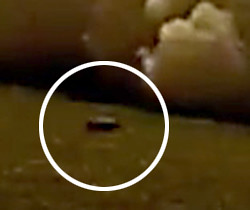
Tags: aehf, armadillo, atlas 5, atlas v, atlas v 531, go pro, go pro hd, gopro, ula
Posted in Cool Stuff, Rockets & Launches | 1 Comment »
Monday, September 23rd, 2013

CBS Baltimore reports on the Comet ISON, which could prove to be quite a spectacle. The northern hemisphere, for example, will get to see the comet around 11 December 2013
The comet was discovered by ISON (Пулковская кооперация оптических наблюдателей), hence the naming. NASA Science put together this story, explaining it comprehensively…
So it all depends on whether the Sun obliterates it on the go-around.
Remember to check the Hubble ISONblog for updates.
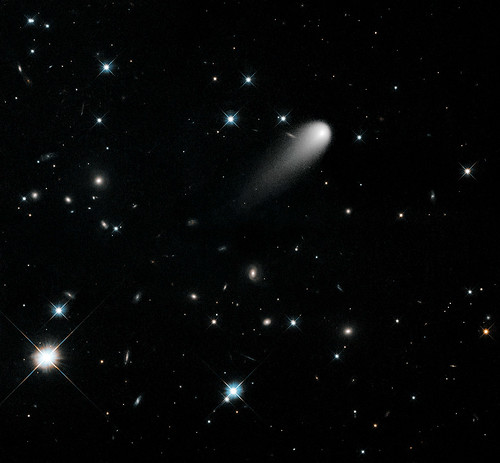
Tags: comet ison, ison, nasa, sungrazer, sungrazer comet
Posted in Astronomy, Cool Stuff, Space Exploration | 1 Comment »
Thursday, September 19th, 2013
This is awesome. McGill University Masters candidate Timothy Blaise produced this video to accompany his thesis.
The lyrics…
Is string theory right?
Is it just fantasy?
Caught in the landscape,
Out of touch with reality
Compactified
On S5 or T*S3
Space is a pure void
Why should it be stringy?
Because it’s quantum not classical
Nonrenormalizable
Any way you quantize
You’ll encounter infinity
You see
Quanta
Must interact
Via paths we understand
Using Feynman diagrams
Often, they will just rebound
But now and then they go another way
A quantum
Loooooop
Infinities will make you cry
Unless you can renormalize your model
Of baryons, fermions
And all other states of matter
Curved space:
The graviton
Can be thought of as a field
But these infinities are real
In a many-body
Loop diagram
Our results diverge no matter what we do…
A Quantum Soup (any way you quantize)
Kiss your fields goodbye
Guess Einstein’s theory wasn’t complete at all!
I see extended 1-D objects with no mass
What’s their use? What’s their use? Can they give us quark plasma?
What to minimize?
What functional describes this
String?
Nambu-Goto! (Nambu-Goto)
Nambu-Goto! (Nambu-Goto)
How to quantize I don’t know
Polyakov!
I’m just a worldsheet, please minimize me
He’s just a worldsheet from a string theory
Reperametrized by a Weyl symmetry!
Fermi, Bose, open, closed, orientable?
Vibrations
Modes! They become particles (particles!)
Vibrations
They become particles (particles!)
Vibrations
They become particles (particles!)
Become particles (particles!)
Become particles (many many many many particle…)
Modes modes modes modes modes modes modes!
Oh mamma mia mamma mia,
Such a sea of particles!
A tachyon, with a dilaton and gravity-vity-VITY
(rock out!)
Now we need ten dimensions and I’ll tell you why
(anomaly cancellation!)
So to get down to 4D we compactify!
Oh, Kahler!
(Kahler manifold)
Manifolds must be Kahler!
(Complex Reimannian symplectic form)
If we wanna preserve
Any of our super-symmetry
(Superstrings of type I, IIa and IIb)
(Heterotic O and Heterotic E)
(All are one through S and T duality)
(Thank you Ed Witten for that superstring revolution and your new M-theory!)
(Maldecena!)
(Super-Yang-Mills!)
(Type IIB String!)
Dual! Dual!
(In the AdS/CFT)
(Holography!)
Molecules and atoms
Light and energy
Time and space and matter
All from one united
Theory
Any way you quantize…
Lyrics and arrangement by Tim Blais and A Capella Science
Original music by Queen
Tags: bohemian gravity, bohemian rhapsody, mcgill, physics, quantum theory, string theory
Posted in Around the Blogs, Cool Stuff | Comments Off on Bohemian Gravity
Tuesday, September 17th, 2013

Great program for encouraging interest in STEM education: FMA Live! Now with “hip hop” in the press release.
Created by Honeywell and NASA in 2004, FMA Live! is an award-winning, 45-minute, live hip hop science education program targeted at the middle school level. The FMA Live! tour has traveled 99,969 miles to bring science to life for over 323,484 students at 887 middle schools in all 48 contiguous U.S. states, Mexico and Canada.
Tags: education, fma live, honeywell, nasa, newton's laws, stem education
Posted in Cool Stuff, NASA | Comments Off on FMA Live!
Tuesday, September 17th, 2013
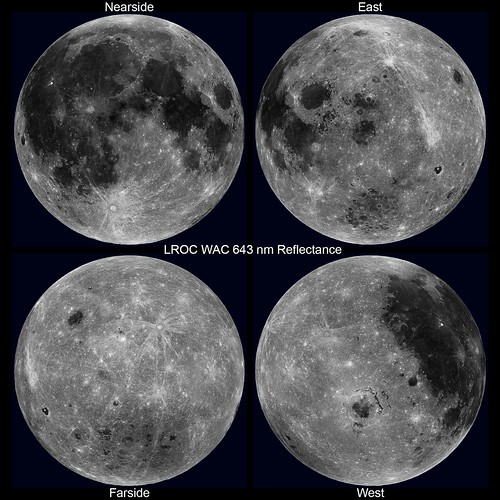
Pink Floyd has sold more than 40 million copies of the album “Dark Side of the Moon” — the title refers to lunacy, not the actual Moon.
Today’s APOD features something we’ve never seen before: the rotating moon…
No one, presently, sees the Moon rotate like this. That’s because the Earth’s moon is tidally locked to the Earth, showing us only one side. Given modern digital technology, however, combined with many detailed images returned by the Lunar Reconnaissance Orbiter (LRO), a high resolution virtual Moon rotation movie has now been composed. The above time-lapse video starts with the standard Earth view of the Moon. Quickly, though, Mare Orientale, a large crater with a dark center that is difficult to see from the Earth, rotates into view just below the equator. From an entire lunar month condensed into 24 seconds, the video clearly shows that the Earth side of the Moon contains an abundance of dark lunar maria, while the lunar far side is dominated by bright lunar highlands. Two new missions are scheduled to begin exploring the Moon within the year, the first of which is NASA’s Lunar Atmosphere and Dust Environment Explorer (LADEE). LADEE, which launched just over a week ago, is scheduled to begin orbiting the Moon in October and will explore the thin and unusual atmosphere of the Moon. In a few months, the Chinese Chang’e 3 is scheduled to launch, a mission that includes a soft lander that will dispatch a robotic rover.
Maybe Syd Barrett can see it.
Tags: dark side of the moon, lro mission, lroc wac, LROC Wide Angle Camera, moon, nasa, pink floyd
Posted in Astronomy, Cool Stuff, NASA, Space Exploration | Comments Off on Dark Side of the Moon
Monday, September 16th, 2013
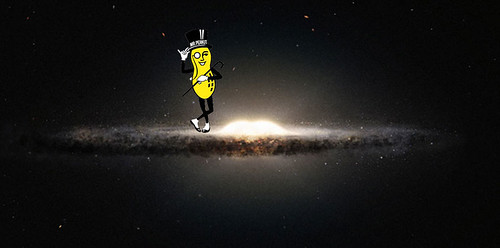
Ian O’Neill’s piece on a “supermassive peanut” at the center of our galaxy caught my attention.
The central bulge of our galaxy contains around 10,000 million stars and spans thousands of light-years, but due to the obscuring dust and gas intermingled with this stellar hive, the overall shape of the bulge is poorly understood. Previous data from the Two Micron All Sky Survey (2MASS) project suggested the central galactic bulge was X-shaped — in a similar fashion to other galaxies observed in the Universe.
But using high resolution infrared data from VISTA, a better idea of the bulge’s shape has been mapped.
By focusing on 2 million red giant stars whose properties are well understood, very precise distances could be calculated. By doing this, a 3-dimensional model of the galactic bulge could be constructed.
“We find that the inner region of our Galaxy has the shape of a peanut in its shell from the side, and of a highly elongated bar from above”, said Ortwin Gerhard, co-investigator and leader of the Dynamics Group at the Max Planck Institute for Extraterrestrial Physics (MPE) in Garching, Germany. “It is the first time that we can see this clearly in our own Milky Way, and simulations in our group and by others show that this shape is characteristic of a barred galaxy that started out as a pure disc of stars.”
The second team of astronomers led by Sergio Vásquez, of the Pontificia Universidad Católica de Chile, Santiago, Chile, took a different approach to arrive at a similar conclusion. By comparing images of the central bulge 11 years apart using the MPG/ESO 2.2-metre telescope, tiny shifts due to the motions of the bulge stars across the sky were measured. This betrayed the shape of the bulge.
“The stars we have observed seem to be streaming along the arms of the X-shaped bulge as their orbits take them up and down and out of the plane of the Milky Way. It all fits very well with predictions from state-of-the-art models!” said Vásquez.
Both groups of astronomers believe that the center of the galaxy started out as a flat disk of stars, but over the aeons became buckled and warped, eventually settling into the modern day “peanut.”
Check out the ESO’s Top 100 images, some of which are available for purchase as HUGE prints here.
Tags: big bang prints, milky way, peanut galaxy, supermassive peanut
Posted in Astronomy, Cool Stuff | Comments Off on Big Bang Monday: Go Nuts
Thursday, September 12th, 2013
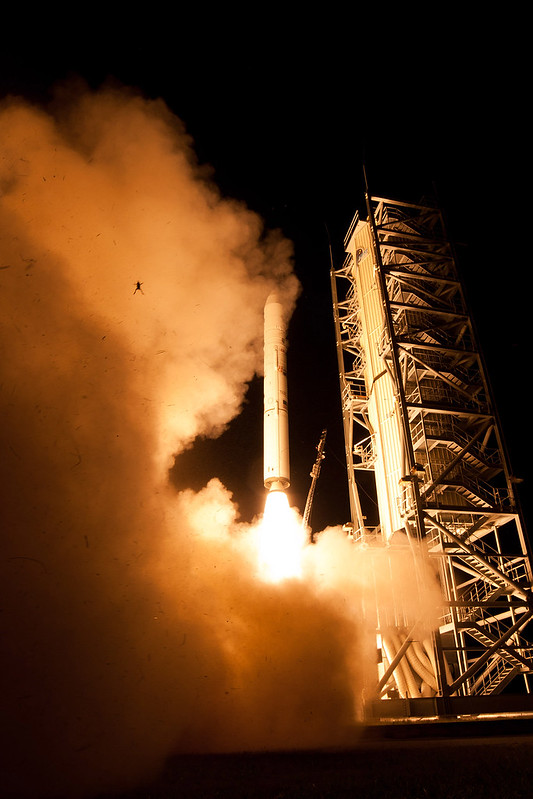
Yes, that’s a real frog.
LADEE Frog Photobomb
Date: 6 Sep 2012
A still camera on a sound trigger captured this intriguing photo of an airborne frog as NASA’s LADEE  spacecraft lifts off from Pad 0B at Wallops Flight Facility in Virginia. The photo team confirms the frog is real and was captured in a single frame by one of the remote cameras used to photograph the launch. The condition of the frog, however, is uncertain.
spacecraft lifts off from Pad 0B at Wallops Flight Facility in Virginia. The photo team confirms the frog is real and was captured in a single frame by one of the remote cameras used to photograph the launch. The condition of the frog, however, is uncertain.
Credit: NASA Wallops Flight Facility/Chris Perry
There’s no way you can catch it when watching the video (duh)…
Tags: frog, frog photobomb, ladee, ladee launch, wallops
Posted in Cool Stuff, NASA, Rockets & Launches | 1 Comment »
Friday, September 6th, 2013
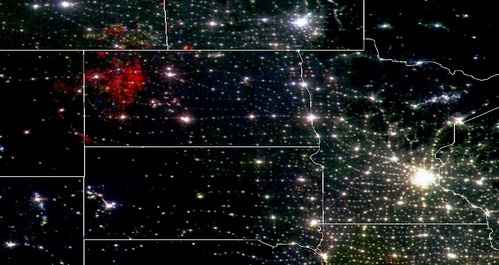
SkyTruth’s view of the Bakken from space. The red stuff at the upper left is rig lighting and flaring from oil and gas drillers working the Bakken Shale. The bright area on the right is the city of Minneapolis.
The folks over at SkyTruth are doing a really good job, using existing observation spacecraft and they’re ready to send up a balloon to document what other ways frackers are polluting.
I missed this coverage over the summer…
Thanks to that and lots of other people, they’ve met their funding goal on indiegogo. The project…
SkyTruth is teaming up with Space for All for a skytruthing mission over the massive Bakken shale oil and gas fields in western North Dakota. We’re planning to launch a sensor package from the ground to the edge of space tethered to a high altitude balloon rig, courtesy of Space for All. We will combine on the ground observations with detections from the balloon rig and measurements we are making from space to measure the amount of natural gas flaring there. This will help us test the accuracy of our satellite-based flaring detections so we can do a better job of monitoring and reporting on the amount of environmentally damaging (and unnecessary and wasteful) flaringthat happens in the Bakken and elsewhere in the world. The more good data we can collect on when, where, and how much, the more we can help groups that are working to reduce and eliminate it. This is what we mean by skytruthing – using remote sensing and mapping to understand and change the world.
Read more about the Bakken and oil shale fracking in this great piece by National Geographic: The New Oil Landscape
Watch their video pitch…
Hat tip to Motherboard.
Tags: bakken, bakken shale, flaring, fracking, global warming, hydraulic fracturing, skytruth, space for all
Posted in Around the Blogs, Cool Stuff, Observation, Satellites | 1 Comment »
Monday, August 26th, 2013
Tags: balloon, darth vader, star wars
Posted in Cool Stuff | Comments Off on Darth Vader Balloon







 spacecraft lifts off from Pad 0B at Wallops Flight Facility in Virginia. The photo team confirms the frog is real and was captured in a single frame by one of the remote cameras used to photograph the launch. The condition of the frog, however, is uncertain.
spacecraft lifts off from Pad 0B at Wallops Flight Facility in Virginia. The photo team confirms the frog is real and was captured in a single frame by one of the remote cameras used to photograph the launch. The condition of the frog, however, is uncertain.
